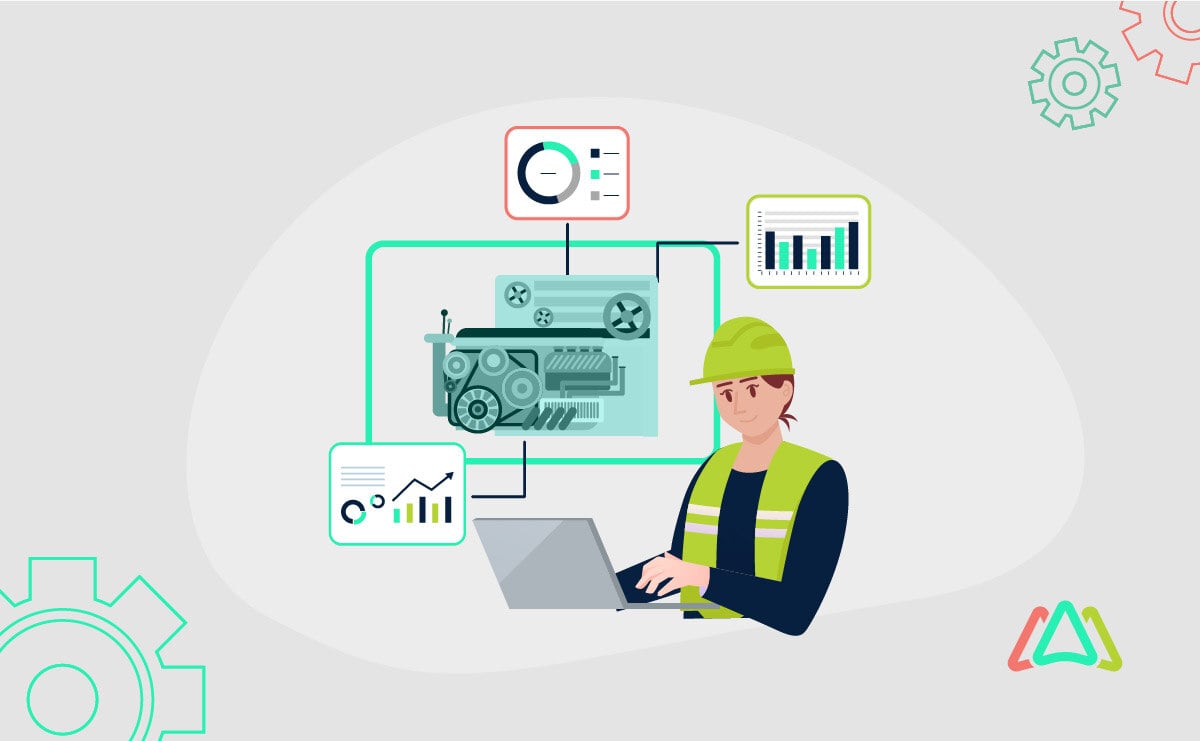
Improving Maintenance Outcomes with Automated Data Collection: Key Strategies and Tools
As technology continues to evolve, automating data capture is becoming an increasingly relevant component in improving maintenance outcomes in various industries. With this added capability, organizations can streamline their processes, reduce downtime, and make more informed decisions. These can all be achieved by integrating automated data capture systems with computerized maintenance management systems (CMMS).
This article explores key strategies and tools for automating data capture, the benefits of using automated data collection systems, and how Robotic Process Automation (RPA) can revolutionize maintenance practices. Let's delve into computerized data capture and its impact on maintenance operations.
The Importance of Accurate Data Collection in Maintenance Operations
Accurate data collection is crucial in maintenance operations for a variety of reasons. First, it ensures that maintenance tasks are performed efficiently and effectively. By collecting precise data on equipment performance, maintenance schedules, and downtime, maintenance teams can make informed decisions on when and how to perform maintenance tasks. This not only prolongs the lifespan of equipment but also minimizes unplanned downtime, ultimately saving the company time and money.
Additionally, accurate data collection allows for better trend analysis and predictive maintenance. Maintenance teams can identify patterns and potential issues by tracking key performance indicators before they become critical. This proactive approach to maintenance can significantly reduce the risk of equipment failures and costly repairs.
Furthermore, accurate data collection is essential for compliance and regulatory purposes. Many industries have strict requirements for documenting maintenance activities, and inaccurate or incomplete data can result in fines or legal consequences.
The bottom line is, accurate data collection is fundamental to maintaining efficient and cost-effective operations. By investing in quality data collection processes and technologies, companies can enhance the performance and reliability of their equipment while ensuring compliance with industry regulations.
Key Strategies for Successful Automated Data Collection
Implementing automated data collection in your organization can streamline processes, improve accuracy, and provide valuable insights into your operations. To ensure success, it's important to follow key strategies for automating data capture. Evaluating your current systems can help in understanding where automated data capture processes can be optimized. Let’s now take a closer look at each of these strategic measures.
First, clearly define your goals and objectives for automated data collection. Identify the specific data points you want to collect, how you will use this data, and what outcomes you hope to achieve. This will ensure that your automation efforts are aligned with your business objectives.
Next, carefully evaluate your existing data collection processes and systems. Understand the current data flows, bottlenecks, and areas for improvement. This will help you identify where automation can have the biggest impact and prioritize your efforts accordingly.
When selecting automated data collection tools and technologies, choose solutions that are scalable, flexible, and easy to integrate with your existing systems. Consider factors such as data security, data quality, and compliance requirements to ensure that your automated processes meet industry standards and best practices. CMMSs are widely available and have options to meet organizations of different sizes, needs, and price points.
Last, establish clear processes for monitoring and maintaining your automated data collection system. Regularly review performance metrics, identify areas for optimization, and make adjustments as needed to ensure that your automated data collection processes continue to deliver value over time.
By following these key strategies, you can effectively implement automated data collection in your organization and drive efficiency, accuracy, and insights across your operations.
Tools and Technology Available for Automated Data Collection
Automated data collection is an essential component of modern businesses, allowing for the efficient gathering of large volumes of data in a timely manner. In order to streamline this process, there are several tools and technologies available that help companies collect and organize data seamlessly.
Web Scraping
One popular tool for automated data collection is web scraping software, which allows businesses to extract data from websites in a structured format. These data can then be used for various analytical purposes, such as market research and competitor analysis.
Application Programming Interfaces (APIs)
Another commonly used technology is Application Programming Interfaces (APIs), which provide a convenient way for businesses to access data from other applications and systems.
Data integration platforms like Zapier and Microsoft Power Automate enable companies to automate data collection, including RPA data collection (Robotic Process Automation), which can enhance operational efficiency by automating repetitive tasks. These platforms offer a user-friendly interface that allows even non-technical users to set up automated workflows and data pipelines.
Overall, the availability of these tools and technologies for automated data collection has simplified the process for businesses, enabling them to gather and analyze data more efficiently and effectively. By leveraging these resources, companies can stay ahead of the competition and make informed decisions based on accurate, up-to-date data.
Benefits of Using Automated Data Collection for Maintenance Outcomes
Automated data collection for maintenance outcomes offers numerous benefits for organizations looking to improve their operational efficiency and reduce downtime. By utilizing automated systems to collect and analyze data related to equipment performance and maintenance activities, companies can streamline their processes, identify potential issues before they become major problems, and make data-driven decisions to optimize their maintenance strategies.
Gathering Real-Time Data
One key benefit of using automated data collection for maintenance outcomes is the ability to gather real-time data on equipment performance. This allows maintenance teams to monitor equipment health and performance trends, identify anomalies or early signs of potential failures, and proactively schedule maintenance tasks to prevent costly downtime.
Generating Key Performance Indicators (KPIs)
Additionally, automated data collection enables organizations to track key performance indicators (KPIs) related to maintenance activities, such as mean time between failures (MTBF), mean time to repair (MTTR), and overall equipment effectiveness (OEE). By analyzing this data over time, companies can identify areas for improvement, optimize maintenance schedules, and allocate resources more efficiently.
Integrating with Existing Enterprise Resource Planning (ERP) Systems and Maintenance Management Software (CMMS)
Furthermore, automated data collection systems can integrate with existing enterprise resource planning (ERP) systems and CMMS, providing a centralized platform for storing and analyzing maintenance data. This streamlines data management processes, reduces manual data entry errors, and facilitates data sharing and collaboration across different departments within the organization.
The benefits of using automated data collection for maintenance outcomes are clear: improved operational efficiency, reduced downtime, and optimized maintenance strategies. By leveraging the power of automated systems to collect and analyze maintenance data, companies can gain valuable insights, make smarter decisions, and ultimately enhance their overall reliability and performance. Due to complexity and lack of resources, many organizations shy away from integrating software applications like CMMS and ERPs. Today, however, there are more solutions available that help bridge the gap and simplify integrating business applications.
Best Practices for Utilizing Data Collected for Continuous Improvement
Utilizing data collected for continuous improvement in your business is crucial for driving growth and success. By following best practices, you can ensure that the data you gather is used effectively to make informed decisions and drive positive change within your organization.
First, it's important to establish clear objectives and key performance indicators (KPIs) that align with your business goals. This will help you focus your data collection efforts on the metrics that matter most to your organization's success.
Once you have collected relevant data, it's essential to thoroughly analyze it to identify trends, patterns, and areas for improvement. Implementing data visualization tools and techniques can make complex data more understandable and actionable for decision-makers.
After analyzing the data, it's crucial to prioritize and implement changes based on the insights gained. Regularly track and monitor the impact of these changes to ensure they are driving the desired outcomes.
Last, continuously refine and improve your data collection and analysis processes to ensure that you are consistently leveraging data to drive continuous improvement within your organization. By following these best practices, you can effectively harness the power of data to guide decision-making and optimize performance in your business.
Conclusion and Recommendations for Maximizing Maintenance Outcomes with Automated Data Collection
After delving into the benefits and challenges of using automated data collection for maintenance operations, it is clear that this technology has the potential to improve maintenance outcomes in various industries significantly. From streamlining data collection processes to reducing human error, and providing real-time insights, automated data collection can lead to more efficient maintenance practices and, ultimately, cost savings.
To maximize maintenance outcomes with automated data collection, it is essential to carefully assess the specific needs and requirements of your organization. Conduct a thorough evaluation of your current maintenance processes and identify areas where automated data collection can make a significant impact. Choose the right technology solution that aligns with your goals and integrates seamlessly with your existing systems. Zapier, Tray.io, and Makini.io are examples of a few solutions that IT and maintenance professionals can lean on to integrate their facilities and maintenance management data with other departments.
Training and educating your maintenance team on how to effectively use automated data collection tools are crucial. Ensure that they are fully onboarded and understand how to leverage the technology to its fullest potential. Regularly monitor and evaluate the performance of your automated data collection system to identify areas for improvement and optimization.
Implementing automated data capture systems for maintenance operations can lead to improved efficiency. By continuously refining these automated data capture processes, organizations can achieve optimal maintenance outcomes.
TABLE OF CONTENTS
Keep Reading
Ever find yourself checking into a luxury hotel and expecting a relaxing stay, only to find a ...
11 Apr 2025
Organizations are witnessing swift changes in the business environment and confronting a ...
8 Apr 2025
Last month, news outlets and the entire internet was abuzz with the return of NASA astronauts ...
3 Apr 2025
What comes first - CMMS or predictive maintenance? If your answer is either, it is correct. ...
28 Mar 2025
Artificial intelligence (AI) talk has become commonplace. Today, engaging in business-focused ...
27 Mar 2025
Imagine a world where machines predict, diagnose, and fix their issues before they fail. This ...
25 Mar 2025
A facility maintenance plan is at the core of a facility’s operations. This organized ...
21 Mar 2025
Think of managing your maintenance operations like managing a championship sports team. Just ...
21 Mar 2025
The maintenance sector is battling a severe talent shortage that threatens to undermine ...
7 Mar 2025
Manufacturing maintenance is the backbone of industrial efficiency, ensuring machines run ...
5 Mar 2025
No one likes playing a guessing game when equipment breaks down. Yet, maintenance teams often ...
4 Mar 2025
The size of the preventive maintenance software market is discussed in millions of dollars, ...
4 Mar 2025
The organizational structure and corporate hierarchy vary from company to company. Large ...
28 Feb 2025
Maintenance procedures are essential for ensuring the longevity and reliability of machinery ...
21 Feb 2025
Sustainability is no longer just a buzzword; it's a critical component of corporate social ...
20 Feb 2025
A Computerized Maintenance Management System (CMMS) relies on accurate, well-organized data ...
18 Feb 2025
In an era where technology drives operational efficiency, Computerized Maintenance Management ...
14 Feb 2025
A Computerized Maintenance Management System (CMMS) is a key component of modern maintenance ...
13 Feb 2025
Introduction Maintenance management is the foundation of maintenance operations in industries ...
11 Feb 2025
Introduction A Computerized Maintenance Management System (CMMS) is software designed to help ...
7 Feb 2025







